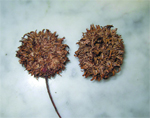 Walkers and bike riders around Rye can’t help but notice them – roundish, spiky, woody things scattered on the lawns, streets, and sidewalks.
Walkers and bike riders around Rye can’t help but notice them – roundish, spiky, woody things scattered on the lawns, streets, and sidewalks.
By Bill Lawyer
Walkers and bike riders around Rye can’t help but notice them – roundish, spiky, woody things scattered on the lawns, streets, and sidewalks.
 The accurate but somewhat ironic common name for these gnarled globes is “sweetgum balls”. Accurate because they are shaped like balls, and they come from the sweetgum trees. Ironic, because while they technically are fruits, they are anything but sweet.
The accurate but somewhat ironic common name for these gnarled globes is “sweetgum balls”. Accurate because they are shaped like balls, and they come from the sweetgum trees. Ironic, because while they technically are fruits, they are anything but sweet.
While sweetgum trees, and their prolifically distributed balls can be found all around Rye and lower New York State, this is about the northern end of their range. One reason they do well here is that they have adapted to grow in acidic soil, which our area has in abundance, thanks to bedrock of metamorphic schist. They also tolerate damp, poorly drained soil, equally prevalent around Rye.
You can see them at Rye Town Park, on Hill Street, and in the old Milton Cemetery, to name just a few locations.
Sweetgum balls look somewhat like the spiky horse chestnut tree balls, or even the fruits of the sycamore trees, but they’re more closely related to witch hazels. They both have “dry” fruit, whereas the spikes of the horse chestnut balls are actually the outer coating that has a nut inside.
Here’s the tricky part. Sweetgum balls, which are 1 to 2 inches in diameter, are more complicated than they appear. They’re composed of 40 to 60 “capsules”. Each capsule, containing one to two small seeds, has a pair of terminal spikes (for a total of 80-120 spikes). When the fruit opens and the seeds released, each capsule is associated with a small hole (40-60 of these) in the compound fruit.
The fruits of the sweetgum trees might be what most people notice, but they actually have colorful flowers that ‘bloom’ in the spring. These are not the bright, large flowers that attract insect pollinators, however. The sweetgum flowers are small clusters that grow at the ends of branches. Male clusters are red, long and generally grow above the female clusters, which are light green, roundish and smaller than the males. The wind performs pollination pleasures.
 Sweetgum trees themselves are quite attractive. They can grow to more than 100 feet high, and have been known to live up to 400 years. Their leaves are deeply lobed and sharply pointed. Bright green in summer, they can turn bright red or yellow in the fall, looking somewhat similar to the leaves of sugar maple trees. But in the northern end of their range they may fall off before turning.
Sweetgum trees themselves are quite attractive. They can grow to more than 100 feet high, and have been known to live up to 400 years. Their leaves are deeply lobed and sharply pointed. Bright green in summer, they can turn bright red or yellow in the fall, looking somewhat similar to the leaves of sugar maple trees. But in the northern end of their range they may fall off before turning.
Their name comes from the fact that their sap (also called resin) is quite abundant and fairly “gummy”. So much so that their genus name is Liquidambar – meaning liquid amber (a rocklike substance that comes from tree sap, made famous by Michael Creighton’s “Jurassic Park” science fiction. )
Some arborists report that sweetgum trees are brittle and more prone than other hardwood trees to drop their branches in storms. Around my Milton neighborhood this hasn’t been the case – at least not in comparison to Norway and silver maples.
For many people (judging by comments on the Internet) the sweetgum balls are a nuisance. They clutter our sidewalks and roads, are hard to rake up, and can be painful on the paws of dogs. One person called them “trash trees”. Some municipalities go so far as to prohibit people from planting them.
While I might not plant one on my property, I don’t consider them that much trouble. One of our neighbors has some pine trees that drop cones on our property, and when my grandchildren come visit we make a game out of seeing who can collect the most.
I’ve read that some people make holiday decorations out of sweetgum balls. Naturalists tell us that sweetgum seeds are very popular with chickadees. And I ask you, who doesn’t love chickadees?















